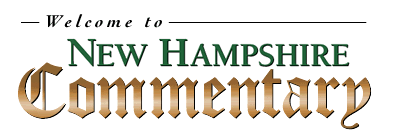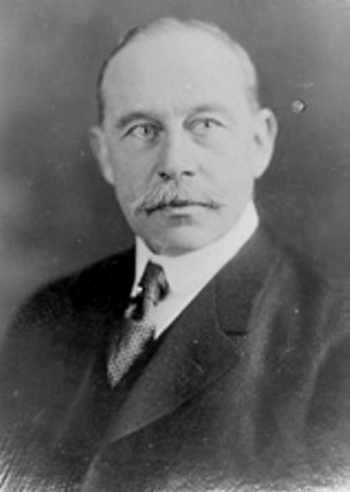

Who is the mystery man in the New Hampshire State House portrait?
Certainly not the late Governor and U.S. Senator Henry W. Keyes
See story as covered by the award winning Nutfield Genealogy blog here


At left is a portrait which hung on the second floor of the N.H. State House since 2005, identified as Henry W. Keyes, who served as governor from 1917-1919 and U.S. Senator from 1919-1937. It was removed in September, 2012 after former State Representative Dean Dexter advise the committee the portrait was not of Keyes, and presented a letter from the Keyes family as confirmation. Later, State Senate researchers identified the "mystery man" at left as that of Congressman Jacob Hart Ela (1820-1884) of Rochester, NH. See congressional biography here. See news story here.
Later, a portrait of Governor/Senator Keyes painted by award-winning New Hampshire artist Craig Pursley was presented to the state on December 5, 2012, and accepted by Governor John H. Lynch and the Executive Council on that date. Later Dexter was invited to hang the portrait on the State House second floor corridor, reserved for portraits of ex-New Hampshire governors.
Portrait of Henry W. Keyes presented to the NH Governor and Council on December 5, 2012. See story here and here.
Photo by Elizabeth Drew, director, NH State House Visitors Center
See Rep. Dexter's Op-Ed column below, which appeared in the New Hampshire Union Leader and Laconia Daily Sun in August, 2012.
______________________________________
By DEAN DEXTER
Go to any bookstore in New Hampshire and in the regional sections, one will find a ridiculous number of books about haunted places in the Granite State, and throughout New England.
I think there are even stories suggesting New Hampshire’s capitol building in Concord is haunted by ghosts. Finished in 1819, it is the oldest state house in the nation in which the legislature still sits in its original chambers, so it’s not surprising.
If there is ever a place that deserves to be haunted, it’s this one. The amount of nefarious deal-making and bargaining with the devil that has gone on here, just in my lifetime, has been enough to wake the dead, if not inspire them actually get up and come over for a visit.
I have never encountered a ghost at the New Hampshire State House, at least that I know of, although I’ve run into my of share shady figures there.
But while walking along the second floor of this grand old place toward the Senate Chamber a month or so ago, I did not encounter a ghost, but instead, came upon a mystery.
Here, I was startled to notice among the oil portraits of past governors, a framed picture that stood out. It was not a painting as the others, but a photograph. Or was it a line drawing of pencil and charcoal? I had walked these halls for years, and never noticed it.
A plaque indicated this was the portrait of one Henry Wilder Keyes of North Haverhill, the state’s governor during World War I (1917-1919), and a three term United States Senator (1919-1937). But of course, this is not Keyes, I muttered (pronounced like skies, not keys).
The man was not in office that long ago, I thought. There are people alive today who have personal knowledge of Governor/Senator Keyes, including his grandchildren.
A review of the Manual of the General Court (1917 edition), also known as the “Red Book,” published by the Secretary of State, has a portrait of Governor Keyes, in his prime. There are also plenty of photographs on file in the Library of Congress and on the Congressional Biography database showing the gracefully aging Senator in later life.
Certainly, if this is not Keyes, who is it?
Keyes’ granddaughter, Frances Parkinson Keyes Keidel, who divides her time between the handsome family estate, Pine Grove Farm in North Haverhill, and a residence, in Devon, Pennsylvania, does not know. And, neither does her cousin, Peter Keyes, of Newbury, Vermont, a retired history professor, and antique book dealer.
“But, this is certainly not my grandfather,” the granddaughter advises. Also, the garb of the man in the picture appears to be from another century.
What apparently has helped confused state officials is a brass plaque on the frame inscribed “Gift of Henry W. Keyes.”
Could it be Keyes’ father, a prominent builder of railroads in the state, or another important citizen a sentimental governor wanted to honor? Doesn’t look like Keyes’ father, either, the grandchildren say.
Whoever it is, Henry Wilder Keyes, deserves better. Bank president, farmer, Keyes humbly served his home town as selectman during his term as governor. He also raised prized blood stock, traveling to Europe in the 1900s, being one of the first to bring pure Holstein cattle to this country. The prize ribbons earned by these animals still dot the walls of the governor’s study, along with a framed vintage state flag, with an old version of the state seal, over the mantel.
At forty, Henry the bachelor farmer, married a girl of 18, which in itself might be worthy of some kind of ribbon. The marriage was a success. Wife, Frances Parkinson Keyes (1885-1970), was a best selling author of magazine articles and over 50 books, mostly novels.
Members of the Keyes family are now thinking about commissioning a portrait of their grandfather, that he might be properly honored. Maybe they should also work on a way of honoring a celebrated former New Hampshire first lady, as well.
As for the man in the bogus portrait? Historians and a senate-house committee are researching that, but at the moment, he remains a mystery.*
Dean Dexter is a former newspaperman who served three terms in the state legislature from Laconia (Ward 4) and as a Belknap County Commissioner. He currently resides in Meredith and Concord.
_______________________________________
*NOTE: The portrait in question was removed from its place in the New Hampshire State House corridor, following a unanimous vote of the Join Legislative Historical Committee on August 21, 2012. The "mystery man" was later identified as Jacob Hart Ela, a Civil War-era congressman from Rochester, NH, and later an auditor with the US Treasury. The Governor and Council accepted an oil painter of Keyes on December 5, 2012, which now hangs in the State House.
See articles in the New Hampshire Union Leader at this link. See "Mystery Solved" story here.
_______________________________________
Henry W. Keyes Portrait Fund Established
Award Winning Artist Craig Pursely was commissioned to execute the portrait of Governor-Senator Keyes, which is now displayed on the second floor corridor of the New Hampshire State House.
For information on how you can donate to the Keyes portrait fund, contact Dean Dexter, committee chairman, PO Box 706, Concord, NH 03302
Posted August 27, 2012/Updated December 5, 2012/January 21, 2013
Return to NH Commentary Home Page
Copyright © 2012 NHCommentary.Com
P.O. Box 706
Concord, NH 03302